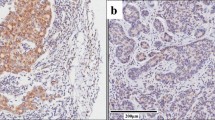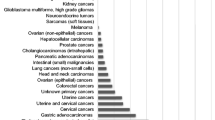Abstract
Accumulating research shows that ovarian cancer progression can be influenced by both gene mutations and endometriosis. However, the exact mechanism at hand is poorly understood. In the current study, we explored the expression of KRAS and SIRT1, two genes previously identified as altered in endometriosis and ovarian cancer. Human endometrial samples were obtained from regularly cycling women with endometriosis, ovarian cancer, and endometriosis-associated ovarian cancer between 18 and 50 of age undergoing hysterectomy, and immunohistochemical analyses were performed. The cytoplasmic expression of KRAS was low in eutopic endometrium from women without endometriosis or ovarian cancer; however, it was elevated in those who have been diagnosed with endometriosis, as well as ovarian cancer with or without the presence of endometriosis. Nuclear and cytoplasmic SIRT1 expression was also low within endometrium without either disease. However, nuclear SIRT1 expression was increased in those with endometriosis and ovarian cancer associated with endometriosis. Nuclear but not the cytoplasmic expression of SIRT1 correlated with KRAS expression in ovarian cancers associated with endometriosis. These results suggest roles of KRAS and SIRT1 in endometriosis and endometriosis-associated ovarian cancer. Cytoplasmic KRAS expression proves to be a key biomarker in both diseases, while nuclear SIRT1 may be a new biomarker specific to those with endometriosis and those with both endometriosis and ovarian cancer. Further research of these genes could aid in determining the pathogenesis of both diseases and help in clarifying the development of endometriosis-associated ovarian cancer.



Similar content being viewed by others
References
Emmanuel C, Gava N, Kennedy C, et al. Comparison of expression profiles in ovarian epithelium in vivo and ovarian cancer identifies novel candidate genes involved in disease pathogenesis. PLoS One. 2011;6(3):e17617.
Weidle UH, Birzele F, Kollmorgen G, Rueger R. Mechanisms and targets involved in dissemination of ovarian cancer. Cancer Genomics Proteomics. 2016;13(6):407–23.
Kwon MJ, Shin YK. Regulation of ovarian cancer stem cells or tumor-initiating cells. Int J Mol Sci. 2013;14(4):6624–48.
King CM, Barbara C, Prentice A, Brenton JD, Charnock-Jones DS. Models of endometriosis and their utility in studying progression to ovarian clear cell carcinoma. J Pathol. 2016;238(2):185–96.
Zhang T, De Carolis C, Man GCW, Wang CC The link between immunity, autoimmunity and endometriosis: a literature update. Autoimmun Rev. 2018; (10):945–955.
Wei JJ, William J, Bulun S. Endometriosis and ovarian cancer: a review of clinical, pathologic, and molecular aspects. Int J Gynecol Pathol. 2011;30(6):553–68.
Anglesio MS, Yong PJ. Endometriosis-associated ovarian cancers. Clin Obstet Gynecol. 2017;60(4):711–27.
Lyttle B, Bernardi L, Pavone ME. Ovarian cancer in endometriosis: clinical and molecular aspects. Minerva Ginecol. 2014;66(2):155–64.
Grandi G, Toss A, Cortesi L, Botticelli L, Volpe A, Cagnacci A. The association between endometriomas and ovarian cancer: preventive effect of inhibiting ovulation and menstruation during reproductive life. Biomed Res Int. 2015;2015:751571.
Takeda T, Banno K, Okawa R, Yanokura M, Iijima M, Irie-Kunitomi H, et al. ARID1A gene mutation in ovarian and endometrial cancers (Review). Oncol Rep. 2016;35(2):607–13.
Worley MJ, Welch WR, Berkowitz RS, Ng SW. Endometriosis-associated ovarian cancer: a review of pathogenesis. Int J Mol Sci. 2013;14(3):5367–79.
DeFrances MC, Debelius DR, Cheng J, Kane LP. Inhibition of T-cell activation by PIK3IP1. Eur J Immunol. 2012;42(10):2754–9.
Bell DA. Origins and molecular pathology of ovarian cancer. Mod Pathol. 2005;18(Suppl 2):S19–32.
Bartosch C, Monteiro-Reis S, Almeida-Rios D, et al. Assessing sirtuin expression in endometrial carcinoma and non-neoplastic endometrium. Oncotarget. 2016;7(2):1144–54.
Nodin B, Zendehrokh N, Sundstrom M, Jirstrom K. Clinicopathological correlates and prognostic significance of KRAS mutation status in a pooled prospective cohort of epithelial ovarian cancer. Diagn Pathol. 2013;8:106.
Warth A, Penzel R, Lindenmaier H, Brandt R, Stenzinger A, Herpel E, et al. EGFR, KRAS, BRAF and ALK gene alterations in lung adenocarcinomas: patient outcome, interplay with morphology and immunophenotype. Eur Respir J. 2014;43(3):872–83.
Jancik S, Drabek J, Radzioch D, Hajduch M. Clinical relevance of KRAS in human cancers. J Biomed Biotechnol. 2010;2010:150960.
Grechukhina O, Petracco R, Popkhadze S, Massasa E, Paranjape T, Chan E, et al. A polymorphism in a let-7 microRNA binding site of KRAS in women with endometriosis. EMBO Mol Med. 2012;4(3):206–17.
Pilarski R, Patel DA, Weitzel J, et al. The KRAS-variant is associated with risk of developing double primary breast and ovarian cancer. PLoS One. 2012;7(5):e37891.
Liu TF, McCall CE. Deacetylation by SIRT1 reprograms inflammation and cancer. Genes Cancer. 2013;4(3-4):135–47.
McBurney MW, Clark-Knowles KV, Caron AZ, Gray DA. SIRT1 is a highly networked protein that mediates the adaptation to chronic physiological stress. Genes Cancer. 2013;4(3-4):125–34.
Lin Z, Fang D. The roles of SIRT1 in cancer. Genes Cancer. 2013;4(3-4):97–104.
Cardenas MG, Oswald E, Yu W, Xue F, MacKerell AD Jr, Melnick AM. The expanding role of the BCL6 oncoprotein as a cancer therapeutic target. Clin Cancer Res. 2017;23(4):885–93.
Yoo JY, Kim TH, Fazleabas AT, et al. KRAS Activation and over-expression of SIRT1/BCL6 contributes to the pathogenesis of endometriosis and progesterone resistance. Sci Rep. 2017;7(1):6765.
Jang KY, Noh SJ, Lehwald N, et al. SIRT1 and c-Myc promote liver tumor cell survival and predict poor survival of human hepatocellular carcinomas. PLoS One. 2012;7(9):e45119.
Daniels JP, Khan KS. Chronic pelvic pain in women. Bmj. 2010;341:c4834.
Pearce CL, Templeman C, Rossing MA, Lee A, Near AM, Webb PM, et al. Association between endometriosis and risk of histological subtypes of ovarian cancer: a pooled analysis of case-control studies. Lancet Oncol. 2012;13(4):385–94.
Kim TH, Yoo JY, Wang Z, Lydon JP, Khatri S, Hawkins SM, et al. ARID1A is essential for endometrial function during early pregnancy. PLoS Genet. 2015;11(9):e1005537.
Ishibashi H, Suzuki T, Suzuki S, Moriya T, Kaneko C, Takizawa T, et al. Sex steroid hormone receptors in human thymoma. J Clin Endocrinol Metab. 2003;88(5):2309–17.
Julious SA. Sample sizes for clinical trials with normal data. Stat Med. 2004;23(12):1921–86.
Kriegl L, Vieth M, Kirchner T, Menssen A. Up-regulation of c-MYC and SIRT1 expression correlates with malignant transformation in the serrated route to colorectal cancer. Oncotarget. 2012;3(10):1182–93.
Barnoud T, Wilkey DW, Merchant ML, Clark JA, Donninger H. Proteomics Analysis Reveals Novel RASSF2 Interaction Partners. Cancers (Basel). 2016;8(3).
Evans-Hoeker E, Lessey BA, Jeong JW, Savaris RF, Palomino WA, Yuan L, et al. Endometrial BCL6 overexpression in eutopic endometrium of women with endometriosis. Reprod Sci. 2016;23(9):1234–41.
Chin LJ, Ratner E, Leng S, et al. A SNP in a let-7 microRNA complementary site in the KRAS 3' untranslated region increases non-small cell lung cancer risk. Cancer Res. 2008;68(20):8535–40.
McVeigh TP, Jung SY, Kerin MJ, Salzman DW, Nallur S, Nemec AA, et al. Estrogen withdrawal, increased breast cancer risk and the KRAS-variant. Cell Cycle. 2015;14(13):2091–9.
Ratner E, Lu L, Boeke M, et al. A KRAS-variant in ovarian cancer acts as a genetic marker of cancer risk. Cancer Res. 2010;70(16):6509–15.
Zou Y, Zhou JY, Guo JB, Wang LQ, Luo Y, Zhang ZY, et al. The presence of KRAS, PPP2R1A and ARID1A mutations in 101 Chinese samples with ovarian endometriosis. Mutat Res. 2018;809:1–5.
Vaziri H, Dessain SK, Ng Eaton E, et al. hSIR2(SIRT1) functions as an NAD-dependent p53 deacetylase. Cell. 2001;107(2):149–59.
Luo J, Nikolaev AY, Imai S, et al. Negative control of p53 by Sir2alpha promotes cell survival under stress. Cell. 2001;107(2):137–48.
Bischoff FZ, Heard M, Simpson JL. Somatic DNA alterations in endometriosis: high frequency of chromosome 17 and p53 loss in late-stage endometriosis. J Reprod Immunol. 2002;55(1-2):49–64.
Haidarali E, Vahedi A, Mohajeri S, Mostafidi E, Azimpouran M, Naghavi BM. Evaluation of the pathogenesis of tumor development from endometriosis by estrogen receptor, P53 and Bcl-2 immunohistochemical staining. Asian Pac J Cancer Prev. 2016;17(12):5247–50.
Lai CR, Hsu CY, Chen YJ, Yen MS, Chao KC, Li AF. Ovarian cancers arising from endometriosis: a microenvironmental biomarker study including ER, HNF1ss, p53, PTEN, BAF250a, and COX-2. J Chin Med Assoc. 2013;76(11):629–34.
Ying TH, Tseng CJ, Tsai SJ, Hsieh SC, Lee HZ, Hsieh YH, et al. Association of p53 and CDKN1A genotypes with endometriosis. Anticancer Res. 2011;31(12):4301–6.
Mhawech P, Kinkel K, Vlastos G, Pelte MF. Ovarian carcinomas in endometriosis: an immunohistochemical and comparative genomic hybridization study. Int J Gynecol Pathol. 2002;21(4):401–6.
Acknowledgments
We are very grateful for financial support provided through the South Carolina Ovarian Cancer Foundation.
Funding
This work was supported by the South Carolina Ovarian Cancer Foundation.
Author information
Authors and Affiliations
Corresponding authors
Ethics declarations
Conflict of Interests
The following authors (BAL, J-WJ, SLY) report potential conflict of interest: Technology related to diagnostic biomarkers for detection of endometriosis is included in a patent pending PCT/US2017/025339.
Rights and permissions
About this article
Cite this article
Teasley, H.E., Beesley, A., Kim, T.H. et al. Differential Expression of KRAS and SIRT1 in Ovarian Cancers with and Without Endometriosis. Reprod. Sci. 27, 145–151 (2020). https://doi.org/10.1007/s43032-019-00017-4
Received:
Accepted:
Published:
Issue Date:
DOI: https://doi.org/10.1007/s43032-019-00017-4




